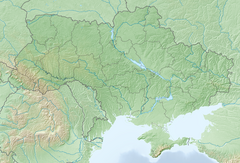Chuhuiv Observational Station
- View a machine-translated version of the Ukrainian article.
- Machine translation, like DeepL or Google Translate, is a useful starting point for translations, but translators must revise errors as necessary and confirm that the translation is accurate, rather than simply copy-pasting machine-translated text into the English Wikipedia.
- Do not translate text that appears unreliable or low-quality. If possible, verify the text with references provided in the foreign-language article.
- You must provide copyright attribution in the edit summary accompanying your translation by providing an interlanguage link to the source of your translation. A model attribution edit summary is
Content in this edit is translated from the existing Ukrainian Wikipedia article at [[:uk:Чугуївська спостережна станція]]; see its history for attribution. - You may also add the template
{{Translated|uk|Чугуївська спостережна станція}}to the talk page. - For more guidance, see Wikipedia:Translation.


 Related media on Commons
Related media on CommonsChuhuiv Observational Station (or Chuguev Observational Station) of the Institute of Astronomy of Kharkiv National University is an astronomical observatory founded in the early 1960s near the village of Ivanovka, Chuhuiv Raion, Kharkiv Oblast, Ukraine. In 2022 the observational station was occupied and severely plundered by Russian soldiers, who during 6 months of occupation stole or damaged most of the scientific equipment.[2][3]
The founder of the observatory was Nikolai P. Barabashov.[4][5] The main instrument of the observatory is 70-cm reflector AZT-8.[6] The observational station hosted one of the first coherent optics processors used to reduce astronomical observations.[7] The main topics of the observations conducted on the observational station are photometric observations of asteroids and monitoring of space debris. In particular, the observations conducted here significantly contributed to the introduction of H-G1-G2 asteroid magnitude system[8] and to the discovery of the YORP effect for several asteroids[9][10]
-
 Windows, damaged by shooting
Windows, damaged by shooting -
 Computer stolen by Russian soldiers
Computer stolen by Russian soldiers -
 Target on a building used for shooting
Target on a building used for shooting -
 CCD-cameras removed from telescopes and used as shooting targets
CCD-cameras removed from telescopes and used as shooting targets
References
- ^ List Of Observatory Codes, Minor Planet Center.
- ^ "Перспективи Чугуївської обсерваторії після окупації". The Universe. Space. Tech. 29 May 2023. Retrieved 30 July 2024.
- ^ Марія Степанюк (4 November 2022). "Чугуївська астрономічна обсерваторія після росіян: подорож разом з астрономами". Ґвара Медіа. Retrieved 30 July 2024.
- ^ Нещерет И. (2019-07-31). "Начальник Чугуевской наблюдательной станции НИИ астрономии рассказал об истории станции и поделился новостями из космоса" (in Russian). Медиа Группа Объектив.
- ^ 200 лет астрономии в Харьковском университете (PDF) (500 экз ed.). Харьков: ХНУ. 2008 – via Шкуратов Ю. Г. (ред.).
- ^ Tereshchenko IA, Shevchenko VG, Kruglyy YN (2010). "Исследование фотометрической системы телескопа АЗТ-8 и ПЗС-камеры IMG 1024S" (PDF). 26 (2) (Кинематика и физика небесных тел ed.): 74–80.
{{cite journal}}: Cite journal requires|journal=(help) - ^ Dudinov VN, Tsetkova VS, Krishtal VA, Gurenko AN, Shpilsky LF (1977). "Когерентно-оптический вычислитель Харьковского университета" (160. Физика Луны и планет. Фундаментальная астрономия) (Вестник Харьковского государственного университета ed.): 65–76.
{{cite journal}}: Cite journal requires|journal=(help) - ^ Karri Muinonen; Irina N. Belskaya; Alberto Cellino; Marco Delbò; Anny Chantal Levasseur-Regourd; Antti Penttilä; Edward F. Tedesco (2010). "A three-parameter magnitude phase function for asteroids". Icarus. 209 (2) (Icarus ed.): 542–555. Bibcode:2010Icar..209..542M. doi:10.1016/j.icarus.2010.04.003 – via Elsevier.
- ^ Ďurech, J.; Vokrouhlický, D.; Kaasalainen, M.; Higgins, D.; Krugly, Yu. N.; Gaftonyuk, N. M.; Shevchenko, V. G.; Chiorny, V. G.; Hamanowa, H.; Hamanowa, H.; Reddy, V.; Dyvig, R. R. (2008). "Detection of the YORP effect in asteroid (1620) Geographos". Astronomy and Astrophysics. 489 (2): L25–L28. Bibcode:2008A&A...489L..25D. doi:10.1051/0004-6361:200810672.
- ^ Durech, J.; Vokrouhlický, D.; Baransky, A. R.; Breiter, S.; Burkhonov, O. A.; Cooney, W.; et al. (November 2012). "Analysis of the rotation period of asteroids (1865) Cerberus, (2100) Ra-Shalom, and (3103) Eger - search for the YORP effect". Astronomy and Astrophysics. 547: 9. arXiv:1210.2219. Bibcode:2012A&A...547A..10D. doi:10.1051/0004-6361/201219396. S2CID 54496050.
External links
- Нещерет И. (2019-07-31). "Начальник Чугуевской наблюдательной станции НИИ астрономии рассказал об истории станции и поделился новостями из космоса" (in Russian). Медиа Группа Объектив.
- 200 лет астрономии в Харьковском университете (PDF) (500 экз ed.). Харьков: ХНУ. 2008 – via Шкуратов Ю. Г. (ред.).
- Tereshchenko IA, Shevchenko VG, Kruglyy YN (2010). "Исследование фотометрической системы телескопа АЗТ-8 и ПЗС-камеры IMG 1024S" (PDF). 26 (2) (Кинематика и физика небесных тел ed.): 74–80.
{{cite journal}}: Cite journal requires|journal=(help) - Dudinov VN, Tsetkova VS, Krishtal VA, Gurenko AN, Shpilsky LF (1977). "Когерентно-оптический вычислитель Харьковского университета" (160. Физика Луны и планет. Фундаментальная астрономия) (Вестник Харьковского государственного университета ed.): 65–76.
{{cite journal}}: Cite journal requires|journal=(help)
- v
- t
- e
 | This article about a specific observatory, telescope or astronomical instrument is a stub. You can help Wikipedia by expanding it. |
- v
- t
- e
















